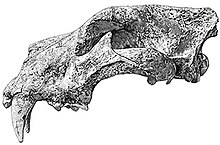
Back أسد أحفوري Arabic Ранноплейстоценски лъв Bulgarian Lleó de les estepes Catalan Panthera leo fossilis Danish Mosbacher Löwe German Panthera leo fossilis Greek Panthera leo fossilis Spanish شیر موسباخ FA Panthera leo fossilis French אריה מאובן HE
| Panthera fossilis Temporal range:
| |
|---|---|

| |
| Skull from Azé, France | |

| |
| Life restoration | |
| Scientific classification | |
| Domain: | Eukaryota |
| Kingdom: | Animalia |
| Phylum: | Chordata |
| Class: | Mammalia |
| Order: | Carnivora |
| Suborder: | Feliformia |
| Family: | Felidae |
| Subfamily: | Pantherinae |
| Genus: | Panthera |
| Species: | †P. fossilis
|
| Binomial name | |
| †Panthera fossilis (Reichenau, 1906)
| |
| Synonyms | |
| |
Panthera fossilis (also known as Panthera leo fossilis or Panthera spelaea fossilis) is an extinct species of cat belonging to the genus Panthera, known from remains found in Eurasia spanning the Middle Pleistocene and possibly into the Early Pleistocene.
Although often historically considered a subspecies of the living lion (Panthera leo), Panthera fossilis is currently either considered to be ancestral to[1] or a chronosubspecies of Panthera spelaea (commonly known as the cave lion or steppe lion).[2][3] In comparison to Late Pleistocene Panthera spelaea specimens, Panthera fossilis tends to be considerably larger,[2] up to 400–500 kilograms (880–1,100 lb), considerably exceeding modern lions in size, and making them among the largest cats to have ever lived.[4][5]
- ^ Sabo, Martin; Tomašových, Adam; Gullár, Juraj (August 2022). "Geographic and temporal variability in Pleistocene lion-like felids: Implications for their evolution and taxonomy". Palaeontologia Electronica. 25 (2): 1–27. doi:10.26879/1175. ISSN 1094-8074. S2CID 251855356.
- ^ a b Marciszak, Adrian; Ivanoff, Dmitry V.; Semenov, Yuriy A.; Talamo, Sahra; Ridush, Bogdan; Stupak, Alina; Yanish, Yevheniia; Kovalchuk, Oleksandr (March 2023). "The Quaternary lions of Ukraine and a trend of decreasing size in Panthera spelaea". Journal of Mammalian Evolution. 30 (1): 109–135. doi:10.1007/s10914-022-09635-3. hdl:11585/903022. ISSN 1064-7554.
- ^ Iannucci, A.; Mecozzi, B.; Pineda, A.; Raffaele, S.; Carpentieri, M.; Rabinovich, R.; Moncel, M.-H. (2024-06-24). "Early occurrence of lion (Panthera spelaea) at the Middle Pleistocene Acheulean site of Notarchirico (MIS 16, Italy)". Quaternary Science. 39 (5): 683–690. Bibcode:2024JQS....39..683I. doi:10.1002/jqs.3639. ISSN 0267-8179.
- ^ Persico, Davide (June 2021). "First fossil record of cave lion (Panthera (Leo) spelaea intermedia) from alluvial deposits of the Po River in northern Italy". Quaternary International. 586: 14–23. Bibcode:2021QuInt.586...14P. doi:10.1016/j.quaint.2021.02.029.
- ^ Marciszak, Adrian; Gornig, Wiktoria (September 2024). "From giant to dwarf: A trend of decreasing size in Panthera spelaea (Goldfuss, 1810) and its likely implications". Earth History and Biodiversity. 1: 100007. doi:10.1016/j.hisbio.2024.100007.